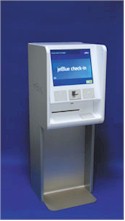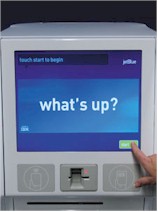News
JetBlue Airways: Kiosks as a strategy
February 29, 2004
 |
Last month, JetBlue Airways, the award winning low-fare passenger airline, kicked off a new customer experience program that included deploying 150 self-service kiosks nationwide. The JetBlue program is part of the company's commitment to offer travelers' added convenience with the purpose of creating a unique experience tailored to the JetBlue brand. The newly designed self-service kiosks are a critical part of the customer experience program that allows customers to check in, select or change their seat assignment, obtain boarding passes and more.
"The customer is always front and center at JetBlue," said Christian Rishel, Director of Interactive Marketing for JetBlue. "We've never been known for thinking 'inside the box' and when we decided to pursue this program our goal was to develop a system based on what our customers want."
JetBlue engaged IBM and its Business Consulting Services group to help develop the program, including manufacturing, and then integrating all of the self service software and hardware with the airline's systems. JetBlue hoped to create a program that focuses on the fundamental belief that customers should enjoy every aspect of their travel experience. With this in mind, IBM worked with JetBlue to customize the systems to reflect the airline's unique branding and personality. To accomplish this, IBM conducted customer focus groups, analyzed passenger traffic flow and developed environmental impact reviews.
 |
Based on its experience designing the award-winning MTA MetroCard Vending Machines, JetBlue called upon the creative work of Antenna Design of New York. Antenna analyzed the transaction flow, created optimum information architecture, designed the graphical user interface and gave the enclosure a welcoming human-like gesture.
"With more than 75 percent of its sales driven by JetBlue.com, JetBlue's customers have clearly embraced self service. Travel companies need to deliver what the customer requests and expects, in the most exciting way possible," said Bruce Speechley, Partner in IBM BusinessConsulting Services Travel and Transportation practice. "As the prevalence and capabilities of self service solutions increases, companies like JetBlue can offer a feature-rich experience with more autonomy for customers while improving their organizations' business performance and processes. JetBlue's focus on the customer experience demonstrates real leadership in the area of self service, which has become a business imperative for travel and hospitality providers," he added.
Based out of New York City's John F. Kennedy International Airport, JetBlue currently operates 214 flights a day and serves 22 destinations in 11 states and Puerto Rico with plans to commence daily nonstop service on March 3 between New York's JFK and Sacramento, CA. With JetBlue, all seats are assigned, all travel is ticketless, all fares are one-way, and a Saturday night stay is never required. In addition, all JetBlue aircraft feature roomy all-leather seats each equipped with free live satellite television, offering up to 24 channels of DIRECTV Programming at every seat.
Getting to the top is hard, but staying there is even more difficult. JetBlue has climbed to the top of the airline industry in popularity with a forward-thinking approach to customers and has been rewarded by a committed customer base and accolades from numerous publications; the airline was named "Best Domestic Airline" for the last two years by the readers of Conde Nast Traveler magazine. The kiosk program is an extension of the company's priority of making travel for their customers as comfortable and convenient as possible.
 |
KIOSK magazine recently had the opportunity to speak with Rishel about the kiosk program, post-deployment. Although JetBlue realizes that many airlines already have had a kiosk program for many years, they think this late entry worked in their favor. "This was one area we needed to play catch up and we tried to create the efficiencies and overcome the mistakes of former kiosk projects, said Rishel. "Things like 17" touchscreens became a nice challenge to compete with what's out there now and we had a huge opportunity to make a branding statement."
The design of the system was chicken before the egg. Rishel said that before even thinking about the enclosure, JetBlue first looked at the user interface. "From the design perspective of the machine the enclosure is quite monochromic ... it's just a frame for what's happening on the screen."
JetBlue does 75 percent of their revenue over its Web site. With their kiosk program they anticipate a similar growth rate with the use of the kiosks and needed a kiosk that would substitute for a human service personnel and yet would come through with a friendly face and great service. "We wanted customers to have the same convenience and services they have already come to expect from us," noted Rishel. So far the strategy appears to be paying off.
Researchwww.jetblue.com www.ibm.com www.antennadesign.com
Originally published in the Mar/Apr 2004 issue ofKioskmagazine.







